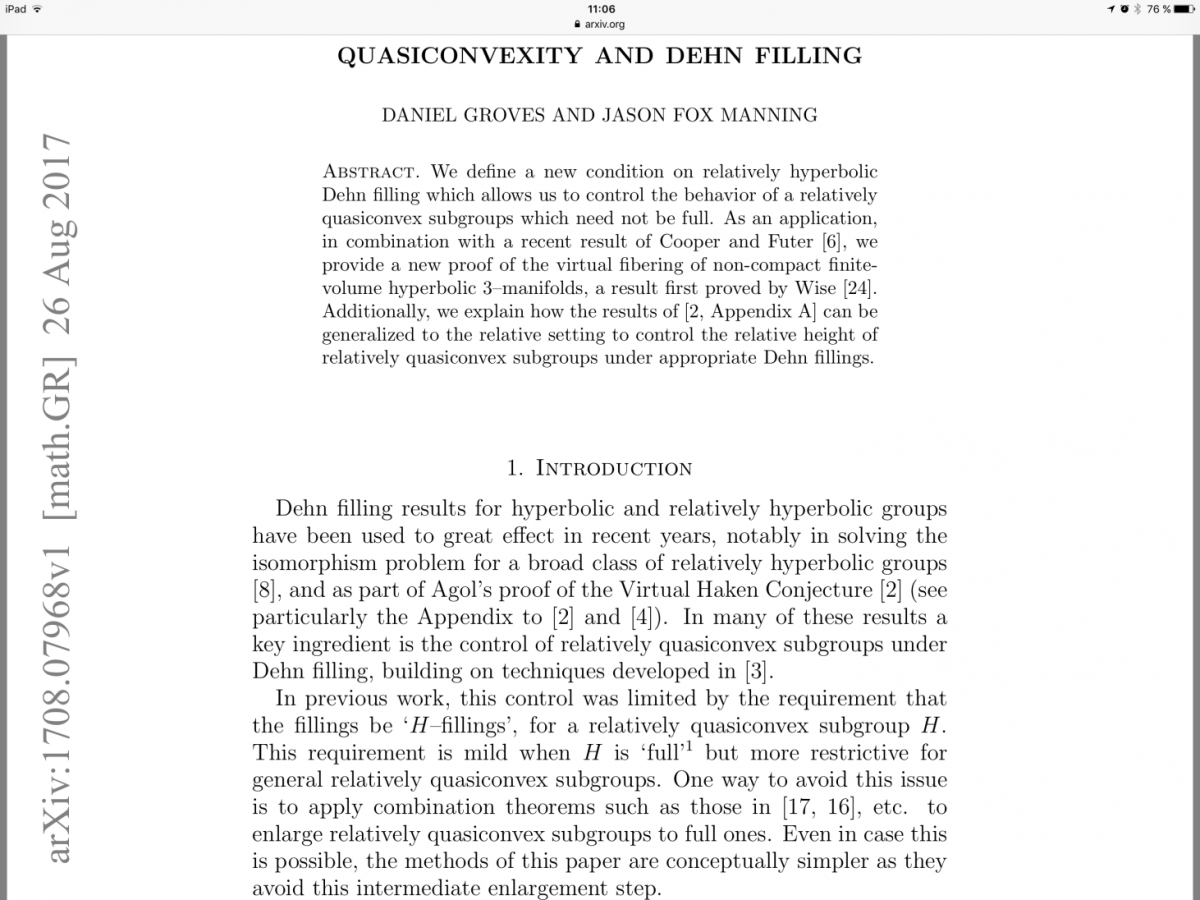One of the most important theorems in 3-manifolds topology is Agol’s Theorem asserting that every closed 3-manifold is virtually fibered and in particular virtually Haken. Agol proved this theorem in early 2012 for closed hyperbolic manifolds. The general (closed) case reduces to hyperbolic manifolds via geometrization.
The case of cusped hyperbolic manifolds was left open by Agol. There is an unpublished manuscript of Daniel Wise from October 2012, which seems to give a proof of virtual fibering for cusped hyperbolic manifolds but is not publicly available so far. (Note that Hakenness of cusped hyperbolic manifolds is known to follow from a standard argument: vanishing of the Euler characteristic implies that \(H^1\) is not trivial, and the Poincaré dual of a nontrivial element is represented by a surface which can be surgered to become incompressible.)
A new paper on the ArXiv gives a new proof of virtual fibering for cusped hyperbolic manifolds.
Groves, Manning: Quasiconvexity and Dehn filling, https://arxiv.org/pdf/1708.07968.pdf
The proof uses Agol’s Theorem for closed manifolds, and also a recent result about quasi-Fuchsian surfaces in finite-volume hyperbolic 3-manifolds saying that the lifts of the quasi-Fuchsian surfaces to \(H^3\) separate any pair of planes \(P_1,P_2\subset H^3\) with \(d(P_1,P_2)>0\) (Cooper, Futer: Ubiquitous quasi-Fuchsian surfaces in cusped hyperbolic 3-manifolds, https://arxiv.org/pdf/1705.02890.pdf
The result of Cooper and Futer implies that fundamental groups of cusped hyperbolic 3-manifolds act geometrically on a CAT(0) cube complex dual to finitely many quasi-Fuchsian surfaces immersed in that manifold. Groves and Manning want to show that this implies the group to be virtually special, i.e., virtually a right-angled Artin group (which in view of Agol’s work implies virtual fibering). To achieve this they use a criterion (Przytycki, Wise: Mixed 3-manifolds are virtually special, https://arxiv.org/pdf/1205.6742.pdf) which says that a group acting freely on a CAT(0) cube complex is virtually special if there are finitely many orbits of hyperplanes, each of the hyperplanes \(A\) has a separable stabilizer, who has finitely many \(Stab(A)\)-orbits of hyperplanes intersecting or osculating with \(A\), and each pair of intersecting hyperplanes \(A,B\) has a separable double coset \(Stab(A)Stab(B)\). (The criterion is a variant of a former criterion from Hsu-Wise. Recall that separability of \(H\subset G\) means that for each \(g\not\in H\) one finds a finite index subgroup containing \(H\) but not \(g\).)
This criterion is from Agol’s proof known to be satisfied for closed manifolds and the authors use Dehn fillings to reduce the cusped case to the closed one. The main technical result that they prove for this purpose is a certain “wideness” condition for Dehn fillings. Namely, for a relatively quasiconvex subgroup \(H\) in a relatively hyperbolic group $G$ they call a normal subgroup $N$ (along which the Dehn filling is performed) to be \((H, S)\)-wide for a finite set \(S\subset G\) if, whenever there are \(h\in H,s\in S\) such that \(hs\in N\), then \(s\in H\). Their main technical results are then certain existence results for \(H\)-wide fillings. For example they show the following result: Suppose that \(P\) is a group and \(B\) is a separable subgroup. For any finite set \(S\) there exists a finite-Index normal subgroup \(K_S\subset P\) so that for any normal subgroup \(N\subset P\) with \(N\subset K_S\), the subgroup \(N\) is \((B,S)\)-wide in \(P\).
